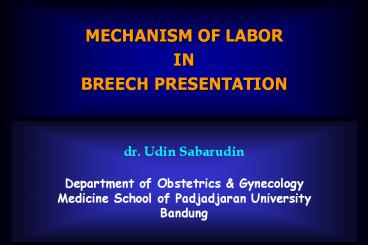dr. Udin Sabarudin - PowerPoint PPT Presentation
Title:
dr. Udin Sabarudin
Description:
MECHANISM OF LABOR IN BREECH PRESENTATION dr. Udin Sabarudin Department of Obstetrics & Gynecology Medicine School of Padjadjaran University Bandung – PowerPoint PPT presentation
Number of Views:452
Avg rating:3.0/5.0
Title: dr. Udin Sabarudin
1
MECHANISM OF LABOR IN BREECH PRESENTATION
dr. Udin Sabarudin Department of Obstetrics
Gynecology Medicine School of Padjadjaran
University Bandung
2
THE 3 TYPES OF BREECH PRESENTATION
- Frank (65) Hips are flexed, knees are
extended. - Complete (10) The hips and knees are
flexed - Incomplete (25) The feet or knees are
the lowermost presenting part. - o Single footling one of the lower
extremities is lowermost. - o Double footling Both of the lower
extremities are lowermost
3
Figure 21-2. Breech presentations. A Right
sacrum posterior (RSP) position. B Left sacrum
anterior (LSA) position. (Redrawn and reproduced,
with permission, from Bumm E Grundiss zum
Studium der Geburtshilfe. Bergmann, 1922)
4
PREDISPOSING FACTORS
- Prematurity
- Uterine abnormalities -Malformation
-Fibroids - Fetal abnormalities -CNS Malformations
- -Neck Masses
- Multiple gestations
- Previous breech delivery
5
Gestational age and frequency of breech birth
Gestational age in weeks Breech
21-24 33
25-28 28
29-32 14
33-36 9
37-40 7
6
DIAGNOSIS
- Palpation and ballottement
- Ultrasound
- Pelvic examination
- X-Ray studies
7
Leopold Maneuver
8
External Cephalic Version
- T
9
MANAGEMENT DURING LABOR
- Type of Delivery
- Vaginal delivery
- Spontaneous
- Partial breech extraction
- Total breech extraction
- Cesarean of delivery
10
Management
11
Three types of vaginal breech delivery exist
- Spontaneous breech (rare) No manipulation of
the infant is necessary, other than supporting
the infant. - Partial breech extraction Fetus descend
spontaneously to where umbilicus is at the
vaginal introitus then, the fetus is extracted
completely. - Total breech extraction The entire body is
extracted. This is indicated only if there is
evidence of fetal distress unresponsive to
routine maneuvers and a cesarean delivery is not
possible.
12
Conditions are unfavorable for breech delivery
- Fetus weight more than 3500 g
- Unfavorable pelvis Breech delivery does not
allow sufficient time for molding of the fetal
head thus, a platypelloid or android pelvis
decreases ability fetal head to navigate maternal
pelvis - Hyperextension of the head increases risk of
cervical spine injury - Footlings- incidence of umbilical cord prolapse
increases with coiling of the umbilical cord
around the legs of the fetus
13
MORTALITY/MORBIDITY
- Increased birth trauma As duration of umbilical
cord compression increases ? deliver the infant
more rapidly ? increasing birth trauma - Decreased birth weight may result from preterm
delivery/growth restriction - Incidence of prolapsed umbilical cord depends on
type of breech presentation Footling 17,
Complete 5, Frank 0,5
14
Mechanism of Labor in Breech Delivery
15
Assisted Delivery of Frank Breech
16
Assisted Delivery of Frank Breech
17
Assisted Delivery of Frank Breech
18
Assisted Delivery of Frank Breech
19
Assisted Delivery of Frank Breech
20
Assisted Delivery of Frank Breech
21
Assisted Delivery of Frank Breech
22
Mechanism of Labor in Breech Delivery
Figure 21-5. Maneuver for delivery of the head.
The fingers of the left hand are inserted into
the infants mouth of over mandible the right
hand exerts pressure on the head from above.
(Modified and reproduced, with permission, from
Benson RCHandbook of Obstetrics Gynecology,
8th ed. Lange, 1983)
23
Mauriceau Maneuver
24
- Delivery of the Aftercoming Head
- Piper forceps
- Modified prague maneuver
25
Mechanism of Labor in Breech Delivery
Figure 21-12. Application of Piper forceps,
employing towel sling support. The forceps are
introduced from below, left blade first. Aiming
directly and intended positions on sides of the
head. (Reproduced, with permission, from Benson
RCHandbook of Obstetrics Gynecology, 8th ed.
Lange, 1983)
26
Forceps to Aftercoming Head
27
Modified Prague Maneuver
28
Complete or Incomplete Breech Extraction
29
Complete or Incomplete Breech Extraction
30
Complete or Incomplete Breech Extraction
31
Complete or Incomplete Breech Extraction
32
Breech Extraction
33
C-Section Indication
- A large fetus ( gt 3.500 gr )
- A Hyperextended fetus
- Uterine dysfunction
- Footling presentation
- Any degree of contraction or unfavorable shape
restriction - Previous perinatal death or children suffering
from birth trauma
34
COMPLICATIONS
1. Perinatal morbidity and mortality from
difficult delivery 2. Low birthweight from
preterm delivery, growth restriction, or both 3.
Prolapsed cord 4. Placenta previa 5. Fetal,
neonatal, and infant anomalies 6. Uterine
anomalies and tumors 7. Multiple fetuses 8.
Operative intervention, especially cesarean
delivery
35
Thank You































